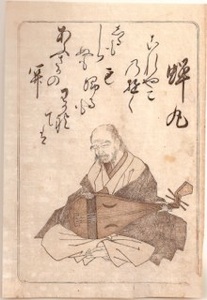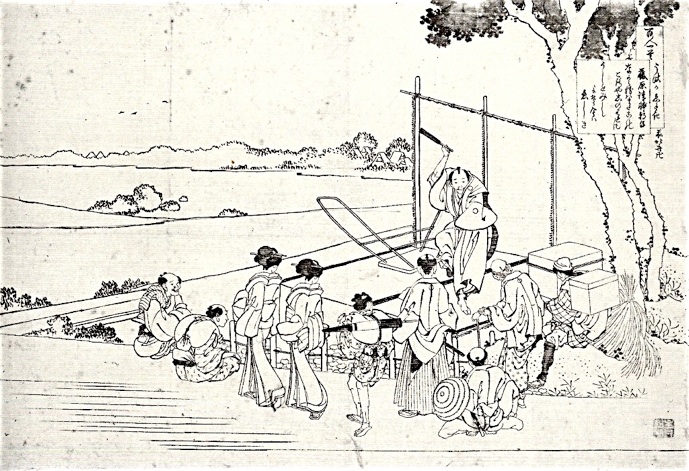藤原清輔朝臣


ながらへば
またこの頃や
しのばれむ
憂しと見し世ぞ
今は恋しき
ふじわらのきよすけあそん
ながらえば
またこのごろや
しのばれん
うしとみしよぞ
いまはこいしき
Fujiwara no Kiyosuke
If I reach old age
Then the present days
May come to mind
And the world now seen as sad
I may dearly cherish.
Hokusai
Fujiwara no Kiyosuke (1104 - 1177), with the title Ason, was a son of Akisuke (poem 79). After his father’s death he became the head of the Rokujo school of poetry. He was the compiler of the ShokuShikashu and wrote treatises on poetry, like the Ogi Sho and Fukuro-zoshi. He belongs to the Thirty-Six Immortal Poets. He has ninety-six poems in imperial anthologies.
Hokusai shows us a scene from his own time. A street actor is performing for farmers, two aristocratic ladies, a samurai (recognizable by his two swords), a merchant, an old man, in short representatives of the whole of Japanese society at that time. In the Tokugawa period, also called the Edo period (1603-1868), many samurai became ronin, or warriors without a lord, and sank in status. Performers like the one in the drawing above, belonged to the lowest ranks and travelled the countryside, but their popularity was rising. Between 1675 and 1837 there had been twenty great famines and the decline of the Tokugawa Shogunate set in. Mass protests over taxes and food shortages had become commonplace. By the 1830s, there was a general sense of crisis. Hokusai worked on his Hyakunin drawings and woodcuts in the last years of his life (1760-1849).
The performer is looking at the samurai and his attendant, and as Peter Morse noticed, he has the same tonsure and clothing as the samurai. Is he a former samurai come down in life? Or just impersonating one? Nevertheless, they are the focus of the drawing. Maybe Hokusai refers to the declining status of the samurai and interprets the poem as such. The entertainer may be performing an ancient samurai tale. Or is the performer only providing a joyful moment for the people around him; one to cherish later?
Shinobu has two meanings, ‘to bear, endure’ referring to the bygone days of the first two lines, or ‘to think of fondly, be nostalgic about’ referring to the following lines; it’s the hinge that connects both parts.
The poem could be interpreted as a cheering up or as a comment on the ongoing decline of the world.


